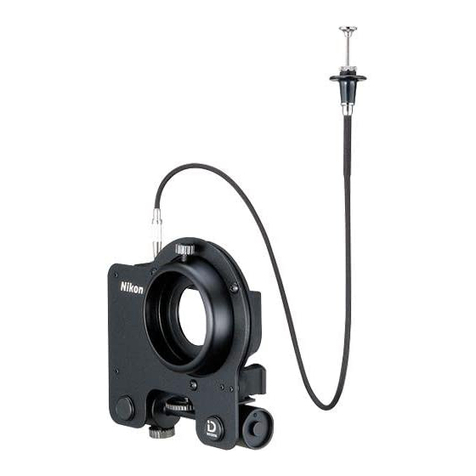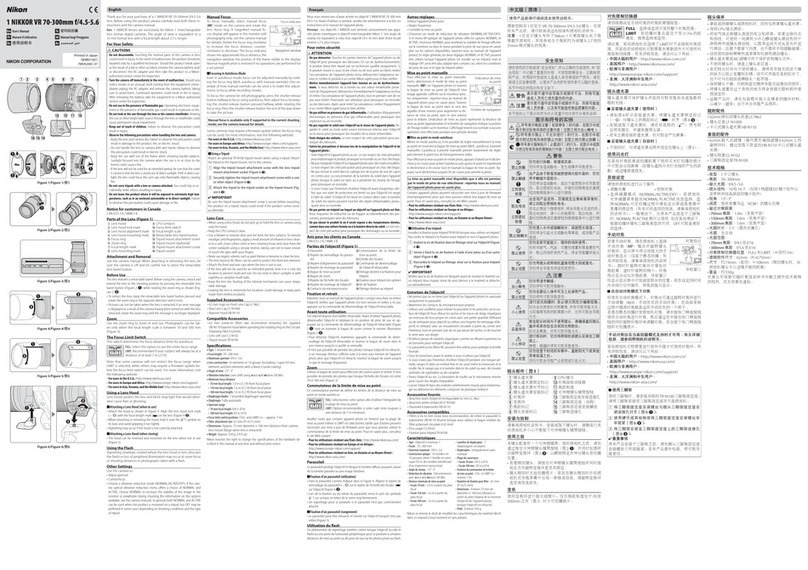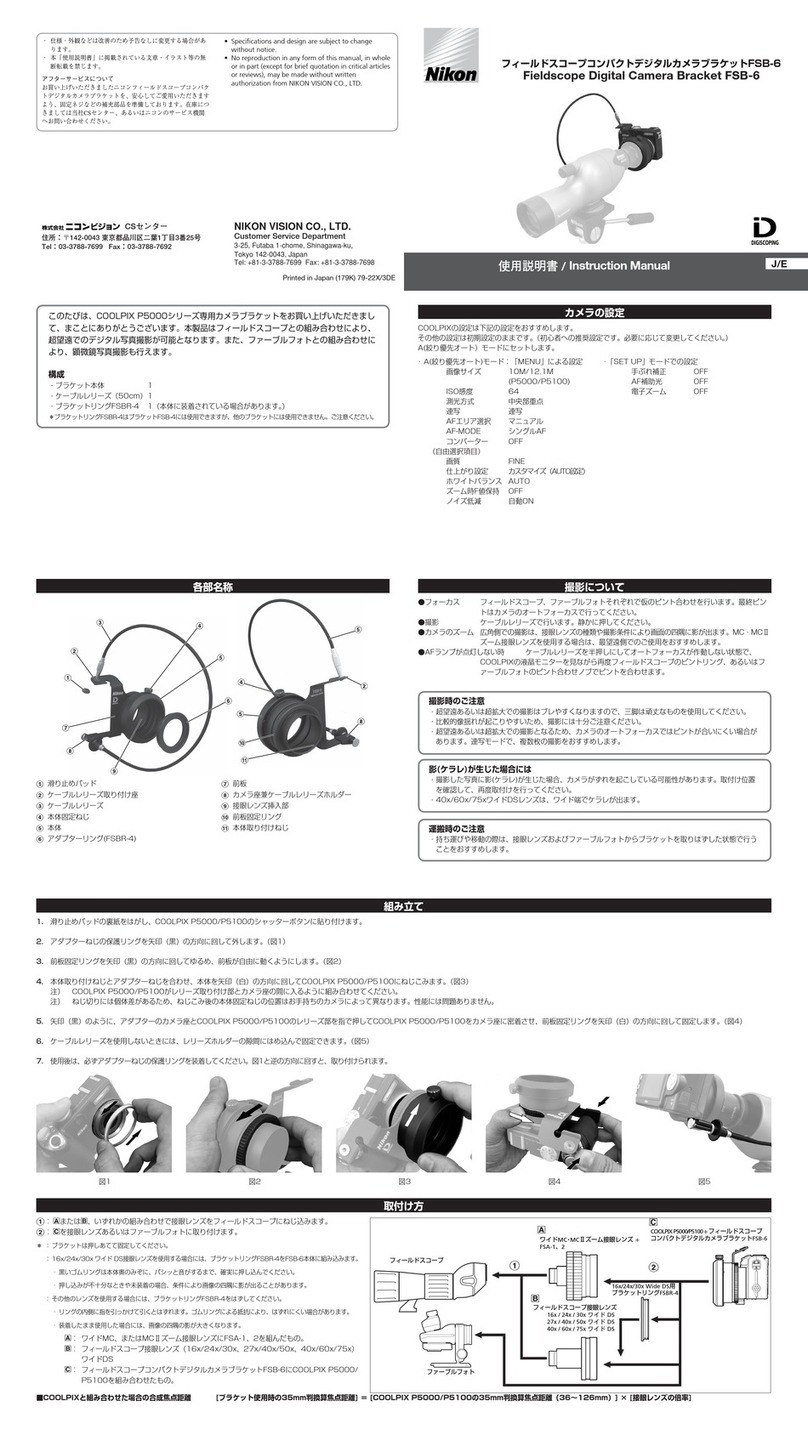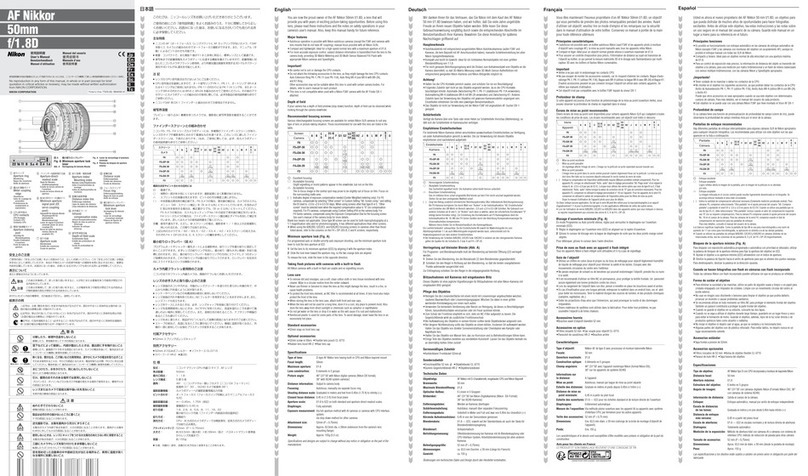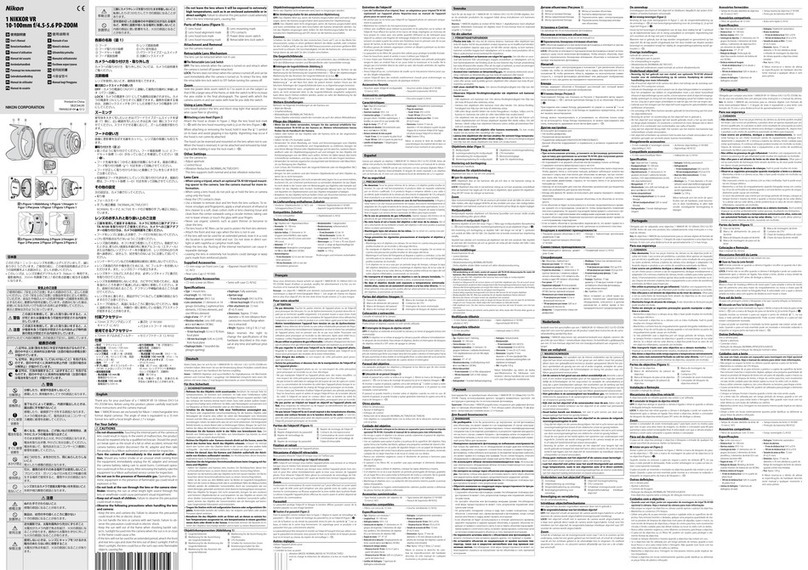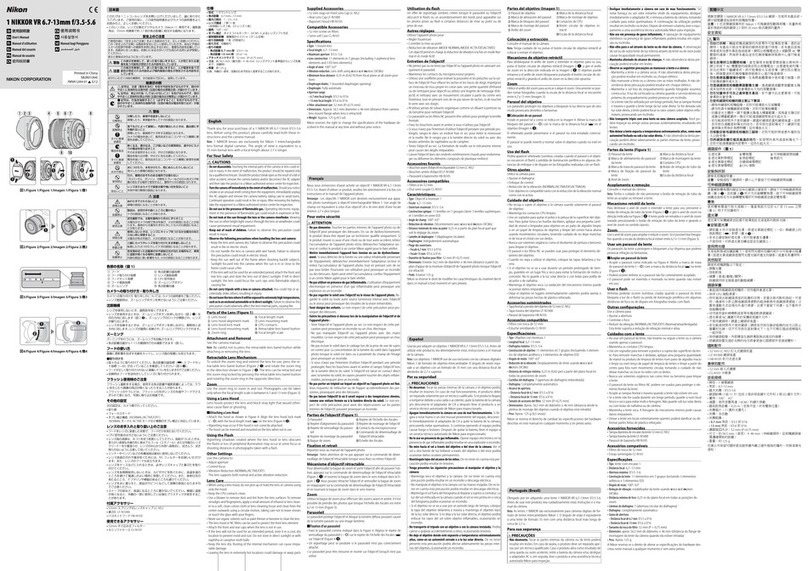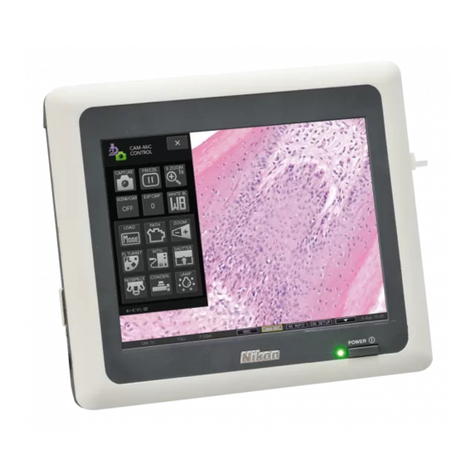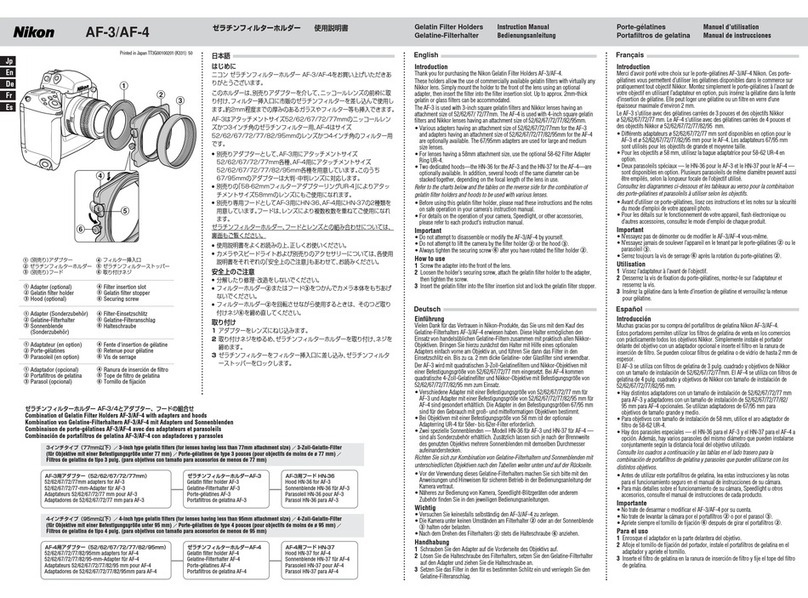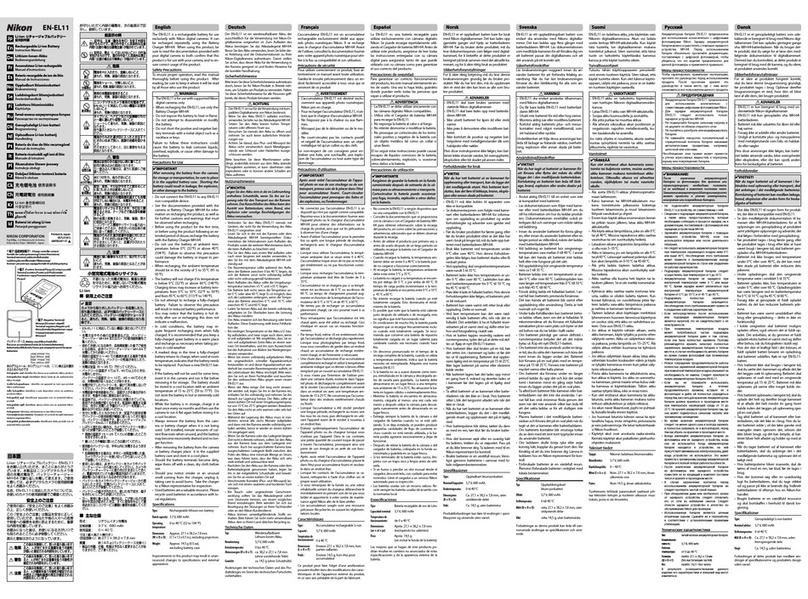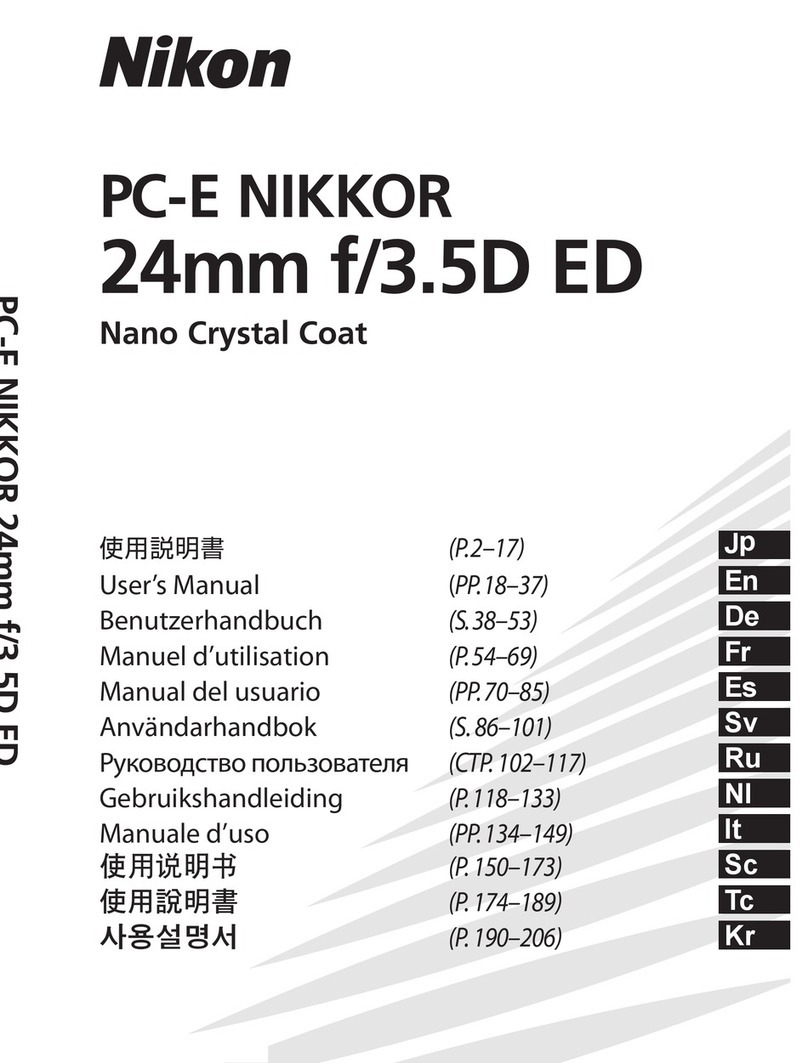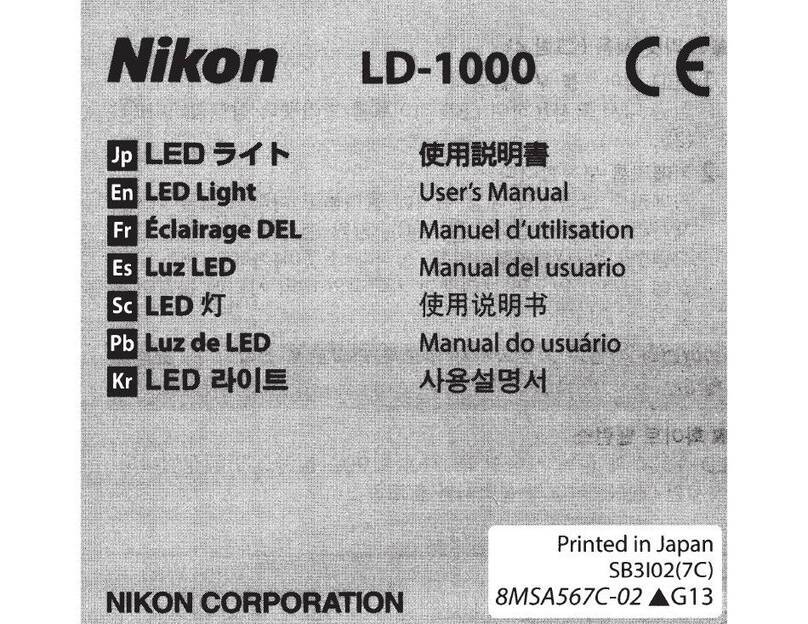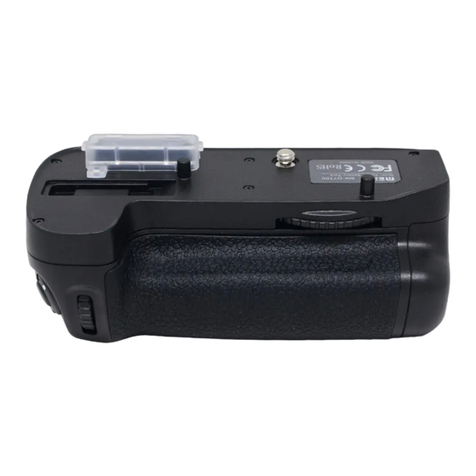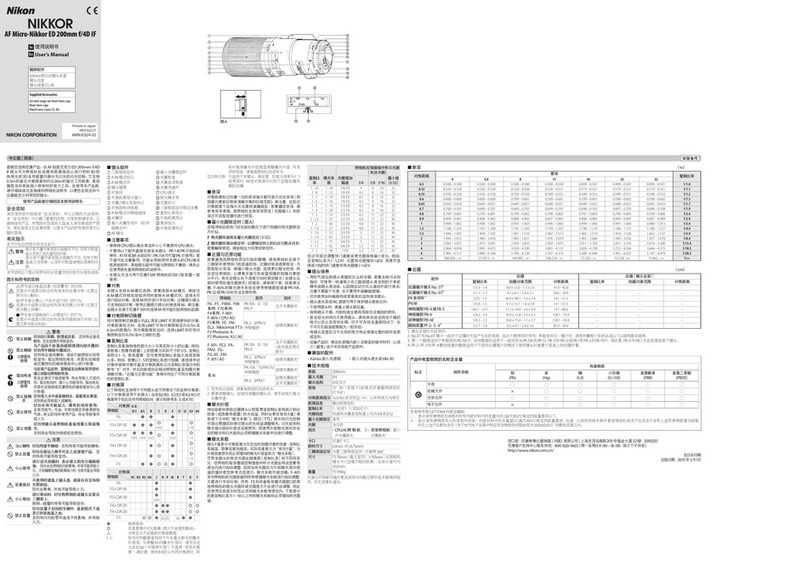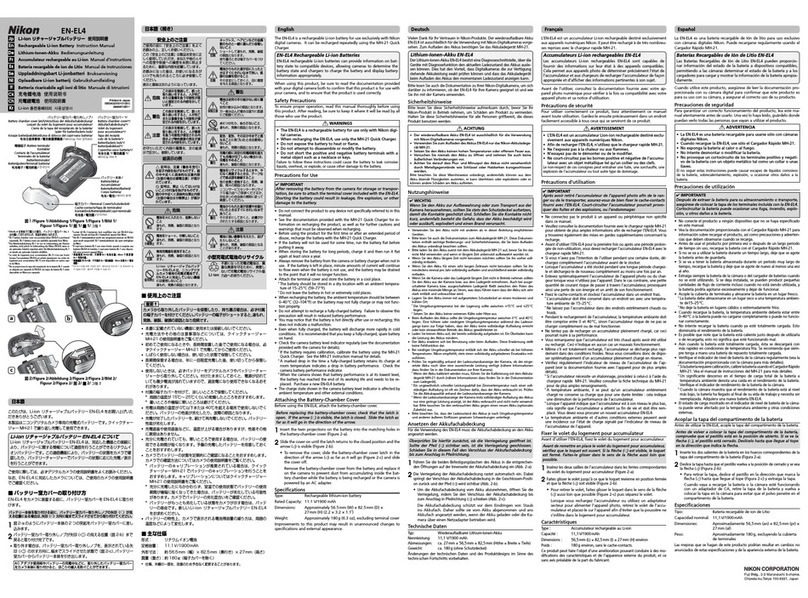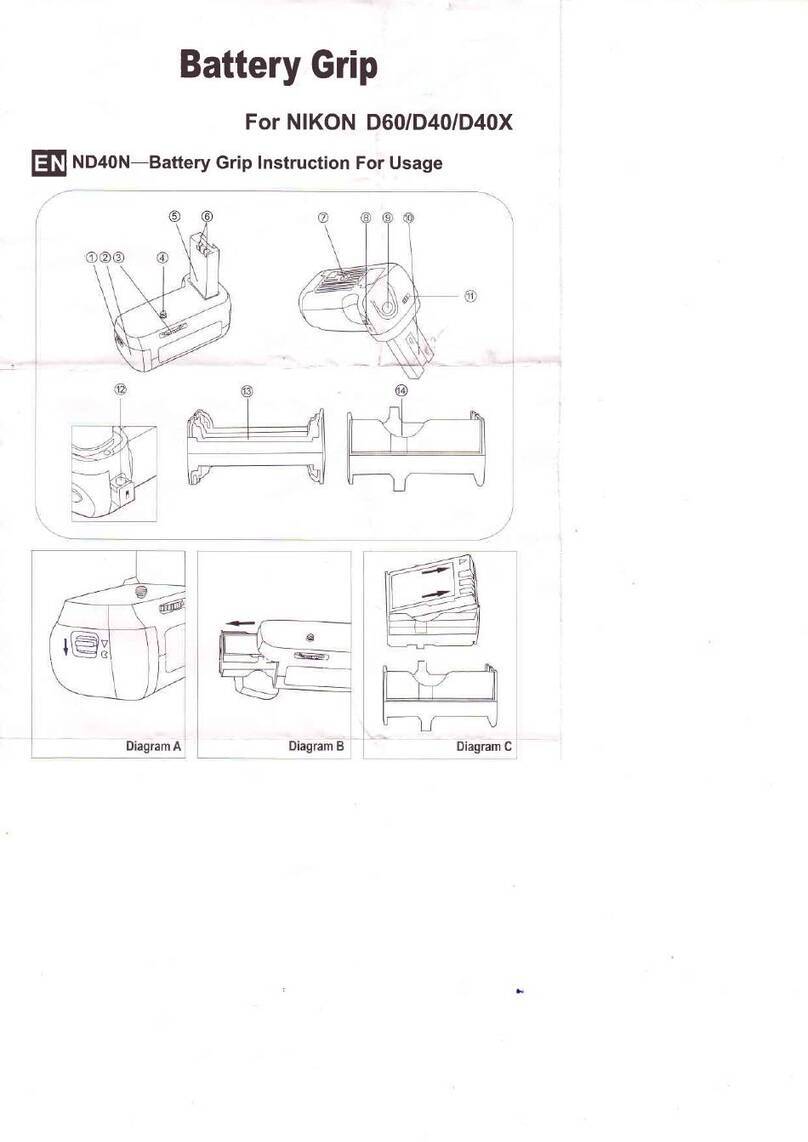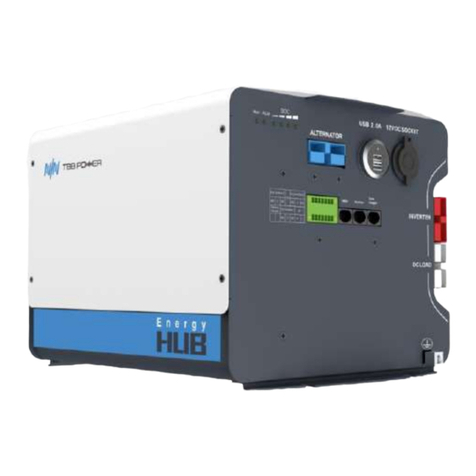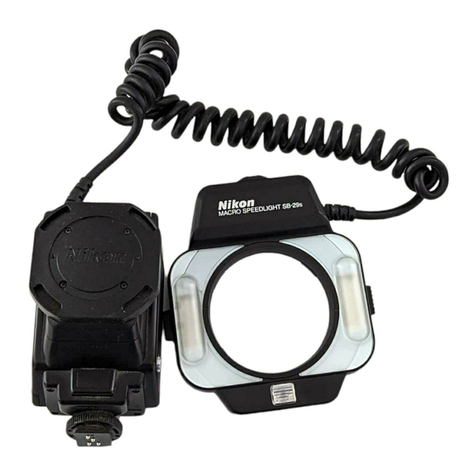Importante
•En lo posible, no moje o manche el filtro con sus dedos. Si se mancha el filtro, limpie con un paño de algodón suave,
limpio, empapado en alcohol etanol puro o solución de limpieza de lentes.
•No deje estos filtros donde queden expuestos a altas temperaturas, humedad o rayos del sol durante mucho tiempo.
Notas sobre el uso de viseras evitando las esquinas negras
•La mayoría de las viseras de bayoneta especiales, excepto ciertos modelos pueden utilizarse sin que aparezcan esquinas
negras. Esto es cierto para la visera roscadas HN-31 para AF 85mm f/1.4D y la visera integrada para AF-S 300mm f/4D.
•No puede utilizar viseras de instalación por deslizamiento en estos filtros. En su lugar, utilice la visera roscada HN-9 para
AF 28mm f/1.4D y HN-22 para 35-200mm f/3.5-4.5.
•En los siguientes objetivos y viseras, el filtro polarizador circular produce esquinas negras.
Español
Introducción
Muchas gracias por su compra del Filtro Polarizador
Circular II de Nikon. Esta línea de filtros fue diseñada para
utilizar con los SLR de enfoque y exposición automásticos.
También sirve para cámaras de enfoque manual y es
efectivo tanto con películas color como blanco y negro.
Principales características
•En general, la luz que se refleja en el agua, vidrio u otros
materiales lustrosos se polariza y afecta negativamente la
definición de la imagen. El filtro polarizador circular reduce
o elimina los reflejos indeseados y aumenta el contraste
general de objetos en situaciones de poco contraste.
•Normalmente la luz del cielo se polariza por los reflejos y
dispersiones del aire. El filtro polarizador circular elimina
estos reflejos para un cielo sea más azul o colores más
intensos.
•Nikon fabricó su línea de Filtros Polarizadores Circulares
II más finos y ligeros que los modelos convencionales,
para que pueda utilizar en muchos objetivos sin que
aparezcan esquinas negras y tiene múlitples capas en
ambos lados para reducir las imágenes fantasmas y
reflejos de luz.
•El Filtro Polarizador Circular II de Nikon tiene el mismo
tamaño de instalación que las roscas delante del objetivo
para que pueda instalar una tapa de objetivo normal.
•Puede utilizar muchas de las viseras de bayoneta
especiales y algunas viseras opcionales con estos filtros
sin que aparezcan esquinas negras (Véase la tabla siguiente).
Accessorios
•Cajas de filtro: CP-10 (para 52mm), CP-11 (para 58mm),
CP-12 (para 62mm), CP-13 (para 67mm),
CP-14 (para 72mm) y CP-15 (para 77mm)
Instalación de los filtros
•Sujete el anillo de instalación del filtro y atornille a la
derecha en la rosca delantera del objetivo.
•El uso de un filtro de otro diámetro o espesor puede
producir esquinas negras. No podemos garantizar el
resultado cuando se usan dos o más filtros uno sobre otro.
Cómo utilizar
•Mientras mira por el visor de la cámara, gire el aro de ajuste
hasta obtener el efecto deseado. Para que el cielo sea un
azul más oscuro, gire el aro de ajuste hasta que la imagen
en el visor se vea más oscura. Puede aparecer una ligera
sombra en el visor pero no en la película en sí.
•En las cámaras AF con matriz tridimensional o medición por
mútiples sensores, puede no ser posible una exposición
correcta. En este caso, utilice una medición con énfasis en
el centro. Para cámaras con medidor de exposición TTL por
el objetivo, no es necesario compensar la exposición. Para
otras cámaras, haga la compensación con aprox. 2 a 4
factores de filtro (+1 a +2 paradas/f).
•Si el cilindro del objetivo gira durante el enfoque automático,
haga el enfoque antes de ajustar el filtro. (El enfoque puede
aparecer ligeramente borroso cuando ajuste el filtro en
ciertas condiciones.) Con una visera de bayoneta especial,
instale la visera después de ajustar el filtro.
Belangrijk
•Wees voorzichtig dat er geen water op het filter spat of dat er vingervlekken op komen. Als er waterdruppels of vingervlekken
op het filter komen, kunt u deze verwijderen met een zacht en schoon katoenen doekje bevochtigd met zuivere ethanolalcohol
of lensreinigingsvloeistof.
•Leg deze filters niet langdurig op plaatsen die blootgesteld staan aan hoge temperaturen, hoge vochtigheid of direct zonlicht.
Opmerkingen betreffende het gebruik van kappen en het voorkomen van vignettering
•De meeste speciale bajonetkappen, met uitzondering van sommige modellen, kunnen gebruikt worden zonder dat
vignettering optreedt. Hieronder valt tevens de speciale inschroeftype kap HN-31 voor de AF 85mm f/1.4D en de
ingebouwde kap voor de AF-S 300mm f/4D.
•Opschuiftype kappen kunnen niet met deze filters worden gebruikt. Gebruik in plaats daarvan de inschroeftype kap
HN-9 voor de AF 28mm f/1.4D en de HN-22 voor de 35-200mm f/3.5-4.5.
•Bij de volgende objectieven en kappen zullen de circulaire polarisatiefilters vignettering veroorzaken.
Nederlands
Inleiding
Hartelijk dank voor de aanschaf van dit Nikon circulair
polarisatiefilter II. Deze serie filters is ontworpen voor gebruik
met Nikon spiegelreflexcamera’s uitgerust met autofocus en
automatische belichtingsregeling. De filters werken ook met
camera’s met handmatige scherpstelling en ze zijn tevens
geschikt voor zowel kleurenfilm als zwart/wit film.
Voornaamste kenmerken
•Over het algemeen zal licht dat gereflecteerd wordt door
water, glas of andere materialen die schitteren,
gepolariseerd worden wat een nadelige invloed heeft op
de beelddefinitie. Een circulair polarisatiefilter vermindert
of elimineert ongewenste reflecties en verbetert het totale
contrast van onderwerpen in een contrastarme situatie.
•Gewoonlijk wordt het licht van de lucht gepolariseerd als
gevolg van reflecties en dispersies in de lucht. Een
circulair polarisatiefilter elimineert deze reflecties
waardoor de lucht blauwer wordt en de kleuren intenser.
•Deze nieuwe serie Nikon circulaire polarisatiefilters II zijn
veel dunner en lichter dan conventionele modellen,
waardoor vele objectieven gebruikt kunnen worden zonder
dat vignettering optreedt, en tevens zijn meerdere
coatinglagen aan beide kanten toegepast waardoor
spookbeelden en lichtvlekken worden voorkomen.
•De Nikon circulaire polarisatiefilters II hebben dezelfde
montage-afmeting als de schroefdraad aan de voorkant
van het objectief waardoor er een normale lensdop op
gezet kan worden.
•Met deze filters kunnen tevens vele speciale
bajonetkappen en andere optionele kappen worden
gebruikt zonder dat vignettering optreedt (zie de
hiernavolgende tabel).
Accessoires
•Filterdoosjes: CP-10 (voor 52 mm), CP-11 (voor 58 mm),
CP-12 (voor 62 mm), CP-13 (voor 67 mm),
CP-14 (voor 72 mm) en CP-15 (voor 77 mm)
Bevestigen van de filters
•Pak de bevestigingsring van het filter vast en schroef het
filter in de richting van de klok op de voorkant van het
objectief.
•Bij gebruik van een filter met een verkeerde diameter of
dikte kan vignettering optreden. Als gelijktijdig twee of meer
filters gebruikt worden, is het mogelijk dat de verwachte
prestaties niet worden verkregen.
Gebruik
•Kijk door de zoeker van de camera en draai aan de
afstelring totdat u het gewenste effect hebt verkregen. Om
de kleur van een blauwe lucht intenser te maken, draait u
aan de afstelring totdat het beeld in de zoeker zo donker
mogelijk is. Het kan gebeuren dat er een geringe
kleurschaduw in de zoeker te zien is, maar deze zal niet op
de film worden opgenomen.
•Bij AF-camera’s met 3D matrix of multisensor belichtings-
meting is het mogelijk dat de juiste belichtingswaarde niet
wordt verkregen. In dat geval kunt u de centrumgerichte
meting gebruiken. Bij camera’s met een TTL belichtings-
meter is er geen belichtingscompensatie vereist. Voor
andere camera’s kunt u een belichtingscompensatie
instellen van circa 2 tot 4 filterfactoren (+1 tot +2 f/stops).
•Bij objectieven waarvan de objectiefvatting draait tijdens AF-
instelling dient u de scherpstelling uit te voeren voordat het
filter wordt afgesteld. (In sommige gevallen kan het
gebeuren dat de scherpstelling een weinig verminderd bij
het afstellen van het filter.) Bij een speciale bajonetkap moet
de kap worden aangebracht nadat het filter is afgesteld.
○: Bruikbaar △: Bruikbaar maar met een weinig vignettering ×: Niet buikbaar
• Bevestig deze filters niet op de volgende objectieven want vignettering kan optreden bij gebruik van enkel het objectief
of wanneer de lenskap is aangebracht: de AF 20mm f/2.8D, de 20mm f/2.8, de 28-85mm f/3.5-4.5 en de AF 35-105mm f/3.5-4.5D
Importante
•Se possibile, evitare di bagnare il filtro o di lasciarvi delle impronte. In caso contrario, rimuovere l’acqua o le impronte
utilizzando un panno di cotone morbido e pulito, inumidito con alcool denaturato puro o soluzione detergente per obiettivi.
•Non lasciare per lungo tempo questo tipo di obiettivi in luoghi soggetti a temperature elevate, alti livelli di umidità o alla luce
diretta del sole.
Note circa l’utilizzo dei paraluce e la vignettatura
•La maggior parte dei paraluce a baionetta, salvo alcuni modelli, possono essere utilizzati senza rischio di effetto vignettatura.
Tra questi, il paraluce ad avvitamento specifico HN-31 per AF 85mm f/1.4D e il paraluce incorporato per AF-S 300mm f/4D.
•Iparaluce tipo a incastro non possono essere utilizzati con questi filtri. Utilizzare quindi il paraluce ad avvitamento HN-9 per
AF 28mm f/1.4D e HN-22 per 35-200mm f/3.5-4.5.
•Con i seguenti obiettivi e paraluce, i filtri polarizzatori circolari causano l’effetto vignettatura.
Italiano
Introduzione
Grazie per aver acquistato il filtro polarizzatore circolare
Nikon II. Questa linea di filtri è stata progettata per essere
utilizzata con i sistemi autofocus Nikon e con le reflex
monobiettivo ad esposizione automatica. Tali filtri sono
inoltre in grado di funzionare perfettamente con fotocamere
con messa a fuoco manuale e con pellicole sia a colori sia
in bianco e nero.
Caratteristiche principali
•In generale, la luce riflessa dall’acqua, dal vetro o da altri
materiali lucenti, viene polarizzata e influenza
negativamente la definizione delle immagini. I filtri
polarizzatori circolari riducono o eliminano i riflessi
indesiderati ed aumentano il contrasto complessivo dei
soggetti in situazioni di scarso contrasto.
•Normalmente, la luminosità del cielo è polarizzata a causa
dei riflessi e della dispersione nell’aria. I filtri polarizzatori
circolari riducono tali riflessi, intensificando il blu del cielo
o accentuando i colori.
•Ifiltri polarizzatori circolari II Nikon sono molto più sottili e
leggeri rispetto ai modelli convenzionali, e consentono
quindi di utilizzare vari obiettivi senza causare l’effetto
vignettatura, nonché di applicare rivestimenti a più strati
su entrambi i lati al fine di ridurre l’effetto immagini
sbiadite e la luce parassita.
•Il filtro polarizzatore circolare Nikon II presenta lo stesso
tipo di collegamento della filettatura anteriore
dell’obiettivo, consentendo l’aggancio di un normale
coperchietto obiettivo.
•Con questo tipo di filtri è possibile utilizzare molti paraluce
a baionetta dedicati ed alcuni paraluce opzionali, senza
causare l’effetto vignettatura (vedi la tabella seguente).
Accessori
•Astucci per filtro:
CP-10 (per 52mm), CP-11 (per 58mm),
CP-12 (per 62mm), CP-13 (per 67mm),
CP-14 (per 72mm) e CP-15 (per 77mm)
Montaggio dei filtri
•Afferrare l’anello di collegamento del filtro e avvitarlo in
senso orario nella filettatura anteriore dell’obiettivo.
•L’utilizzo di un filtro di diametro o spessore differente,
potrebbe causare l’effetto vignettatura. Qualora si
inseriscano due o più filtri contemporaneamente, non sarà
possibile garantire una performance ottimale.
Modalità di utilizzo
•Guardando attraverso il mirino della fotocamera, ruotare
l’anello di regolazione fino ad ottenere l’effetto desiderato.
Per intensificare il blu del cielo, ruotare l’anello di
regolazione finché l’immagine nel mirino diventi più scura. E’
probabile che nel mirino si assista ad un lieve effetto “color
cast” che, tuttavia, non sarà registrato sulla pellicola.
•Con le fotocamere AF a matrice 3D o misurazione “multi-
sensor”, non è possibile ottenere l’esposizione corretta. In
tal caso, utilizzare la misurazione a preferenza centrale. Per
le fotocamere con un esposimetro TTL, non è necessaria
alcuna correzione dell’esposizione. Per altri tipi di
fotocamere, effettuare una correzione dell’esposizione di
circa 2-4 fattori filtro (apertura del diaframma da +1 a +2 ).
•In caso di obiettivo il cui barilotto ruoti durante l’operazione
AF, eseguire la messa a fuoco prima della regolazione del
filtro. (Tenere presente che, durante la regolazione del filtro
in determinate condizioni, la messa a fuoco potrebbe
affievolirsi leggermente). Qualora si utilizzi un paraluce a
baionetta idoneo, collegarlo dopo aver effettuato la
regolazione del filtro. ○: Utilizzabile △: Utilizzabile, ma con leggero effetto vignettatura ×: Non utilizzabile
•Evitare di collegare questi filtri a questi obiettivi poiché l’effetto vignettaura si verifica sia utilizzando l’obiettivo
stesso, sia collegando un paraluce: AF 20mm f/2.8D, 20mm f/2.8, 28-85mm f/3.5-4.5 e AF 35-105mm f/3.5-4.5D
Important
•Si possible, évitez de mouiller le filtre avec de l’eau ou de le salir avec des traces de doigts. En cas de taches d’eau
ou de saletés sur le filtre, éliminez-les avec un chiffon en coton doux et propre humidifié d’alcool éthylique pur ou de
solution de nettoyage pour objectif.
•Ne laissez pas ces filtres à des endroits soumis à des températures élevées, une forte humidité ou en plein soleil
pendant longtemps.
Remarques sur l’emploi des pare-soleil et l’évitement du vignettage
•La plupart des pare-soleil à baïonnette dédiés, sauf certains modèles, sont utilisables sans produire de vignettage. Cela
inclut le pare-soleil vissant dédié HN-31 pour le AF 85mm f/1.4D et le pare-soleil intégré pour le AF-S 300mm f/4D.
•Les pare-soleil à emboîtement ne sont pas utilisables avec ces filtres. Utilisez à la place le pare-soleil vissant HN-9 pour
le AF 28mm f/1.4D et le HN-22 pour le 35-200mm f/3.5-4.5.
•Les filtres polarisants circulaires causeront un vignettage avec les objectifs et pare-soleil suivants.
Français
Introduction
Nous vous remercions pour votre achat de ce filtre
polarisant circulaire II Nikon. Cette gamme de filtres est
conçue pour être utilisée avec les appareils reflex
autofocus, à exposition automatique Nikon. Elle fonctionne
aussi avec les appareils à mise au point manuelle, et est
efficace à la fois avec le film couleur et le film noir et blanc.
Principales caractéristiques
•En général, la lumière réfléchie de l’eau, du verre ou de
matériaux brillant est polarisée et affecte la définition de
l’image. Les filtres polarisants circulaires réduisent ou
éliminent les réflexions indésirables et augmentent le
contraste d’ensemble des sujets dans des situations à
faible contraste.
•Ordinairement, la lumière du ciel est polarisée à cause de
réflexions et dispersions dans l’air. Les filtres polarisants
circulaires coupent ces réflexions, rendant le ciel plus bleu
ou intensifiant les couleurs.
•Nikon a rendu sa gamme de filtres polarisants circulaires
II plus fins et légers que les modèles conventionnels, ce
qui permet l’emploi de beaucoup d’objectifs sans causer
de vignettage, et appliqué un revêtement multicouche sur
les deux côtés pour réduire les images fantômes et le
maculage.
•Les filtres polarisants circulaires II Nikon ont la même
taille de fixation que le filetage avant de l’objectif, ce qui
permet le montage d’un bouchon d’objectif ordinaire.
•Beaucoup de pare-soleil à baïonnette dédiés et certains
pare-soleil en option sont utilisables avec ces filtres sans
produire de vignettage (voir le tableau suivant).
Accessoires
•Boîtes à filtres:
CP-10 (pour 52 mm), CP-11 (pour 58 mm),
CP-12 (pour 62 mm), CP-13 (pour 67 mm),
CP-14 (pour 72 mm) et CP-15 (pour 77 mm)
Fixation des filtres
•Saisissez la bague de fixation du filtre et vissez-la dans le
sens horaire sur le filetage avant de l’objectif.
•L’emploi d’un filtre de diamètre ou d’épaisseur différents
peut causer du vignettage. Les performances ne sont pas
garanties si deux filtres ou plus sont empilés.
Utilisation
•En regardant dans le viseur de l’appareil, tournez la bague
d’ajustement jusqu’à l’obtention de l’effet souhaité. Pour
foncer la couleur d’un ciel bleu, tournez la bague
d’ajustement jusqu’à ce que l’image du viseur devienne plus
sombre. De légers écoulements de couleur peuvent
apparaître dans le viseur, mais ils ne seront pas reproduits
sur le film lui-même.
•Avec les boîtiers AF à mesure matricielle 3D ou multi-
capteurs, l’exposition correcte peut ne pas être obtenue.
Dans ce cas, recourez à la mesure centrale pondérée. Pour
les boîtiers à indicateur d’exposition TTL, aucune correction
d’exposition n’est requise. Pour les autres boîtiers, faites
une correction d’exposition d’environ 2 à 4 facteurs de filtre
(+1 à +2 de valeurs d’ouverture).
•Avec des objectifs dont le barillet tourne pendant le
fonctionnement AF, effectuez la mise au point avant
d’ajuster le filtre. (Notez que la mise au point peut être
légèrement décalée pendant l’ajustement du filtre dans
certaines conditions.) Avec un pare-soleil à baïonnette
dédié, fixez bien le pare-soleil après l’ajustement du filtre. ○: Utilisable △: Utilisable mais avec léger vignettage ×: Non utilisable
•N’attachez pas ces filtres à ces objectifs si du vignettage est produit avec l’objectif lui-même ou
quand un pare-soleil est monté: AF 20mm f/2.8D, 20mm f/2.8, 28-85mm f/3.5-4.5 et AF 35-105mm f/3.5-4.5D.
○: Utizable △: Utilizable pero con esquinas negras ×: No utilizable
•No instale estos filtros en estos objetvos porque aparecen esquinas negras porel objetivo en sí o
cuando se instala la visera: AF 20mm f/2.8D, 20mm f/2.8, 28-85mm f/3.5-4.5 y AF 35-105mm f/3.5-4.5D
Objectif Pare-soleil Diamètre Objectif lui-même Avec pare-soleil
dédiédu filtre
18mm f/3.5 HK-9 72 ○×
AF 24mm f/2.8D HN-1 52 ○×
24mm f/2 HK-2 52 △(légèrement vers le repère ∞)×
24mm f/2.8 HN-1 52 ○△(légèrement vers le repère ∞)
28mm f/2 HN-1 52 △(légèrement vers le repère ∞)×
AF 28mm f/2.8D HN-2 52 ○△(légèrement vers le repère ∞)
28mm f/2.8 HN-2 52 ○△(légèrement vers le repère ∞)
PC 28mm f/3.5 HN-9 72 En position normale: ○En position normale: ○
En position de changement max.: ○En position de changement max.: ×
(légèrement vers le repère ∞)
35mm f/1.4 HN-3 52 ○△(légèrement vers le repère ∞)
35mm f/2 HN-3 52 ○△(légèrement vers le repère ∞)
50mm f/1.2 HS-12 52 ○△(légèrement vers le repère ∞)
50mm f/1.4 HS-9 52 ○△(légèrement vers le repère ∞)
AF 24-50mm f/3.3-4.5D HB-3 62 △(léger au réglage grand-angle) △(léger au réglage grand-angle)
AF 28-105mm f/3.3-4.5D HB-18 62 △(légèrement vers le repère ∞)△(légèrement vers le repère ∞)
35-70mm f/3.3-4.5 HN-2 52 ○×
35-135mm f/3.5-4.5 HN-22 62 ○×
Objetivo Visera Diám.Objetivo en sí Con visera
especial de filtro
18mm f/3.5 HK-9 72 ○×
AF 24mm f/2.8D HN-1 52 ○×
24mm f/2 HK-2 52 △(ligeramente en ajuste ∞)×
24mm f/2.8 HN-1 52 ○△(ligeramente en ajuste ∞)
28mm f/2 HN-1 52 △(ligeramente en ajuste ∞)×
AF 28mm f/2.8D HN-2 52 ○△(ligeramente en ajuste ∞)
28mm f/2.8 HN-2 52 ○△(ligeramente en ajuste ∞)
PC 28mm f/3.5 HN-9 72 En la posición normal: ○En la posición normal: ○
En la posición de cambio máxima: ○En la posición de cambio máxima: ×
(ligeramente en ajuste ∞)
35mm f/1.4 HN-3 52 ○△(ligeramente en ajuste ∞)
35mm f/2 HN-3 52 ○△(ligeramente en ajuste ∞)
50mm f/1.2 HS-12 52 ○△(ligeramente en ajuste ∞)
50mm f/1.4 HS-9 52 ○△(ligeramente en ajuste ∞)
AF 24-50mm f/3.3-4.5D HB-3 62 △(un poco en gran angular) △(un poco en gran angular)
AF 28-105mm f/3.3-4.5D HB-18 62 △(ligeramente en ajuste ∞)△(ligeramente en ajuste ∞)
35-70mm f/3.3-4.5 HN-2 52 ○×
35-135mm f/3.5-4.5 HN-22 62 ○×
Objectief Speciale Filter- Alleen objectief Met kap
kap diameter
18mm f/3.5 HK-9 72 ○×
AF 24mm f/2.8D HN-1 52 ○×
24mm f/2 HK-2 52 △(een weinig bij de ∞instelling) ×
24mm f/2.8 HN-1 52 ○△(een weinig bij de ∞instelling)
28mm f/2 HN-1 52 △(een weinig bij de ∞instelling) ×
AF 28mm f/2.8D HN-2 52 ○△(een weinig bij de ∞instelling)
28mm f/2.8 HN-2 52 ○△(een weinig bij de ∞instelling)
PC 28mm f/3.5 HN-9 72 In de normale stand: ○In de normale stand: ○
In de max. verschuivingsstand: ○In de max. verschuivingsstand: ×
(een weinig bij de ∞instelling)
35mm f/1.4 HN-3 52 ○△(een weinig bij de ∞instelling)
35mm f/2 HN-3 52 ○△(een weinig bij de ∞instelling)
50mm f/1.2 HS-12 52 ○△(een weinig bij de ∞instelling)
50mm f/1.4 HS-9 52 ○△(een weinig bij de ∞instelling)
AF 24-50mm f/3.3-4.5D HB-3 62 △(een weinig bij de groothoek-instelling) △(een weinig bij de groothoek-instelling)
AF 28-105mm f/3.3-4.5D HB-18 62 △(een weinig bij de ∞instelling) △(een weinig bij de ∞instelling)
35-70mm f/3.3-4.5 HN-2 52 ○×
35-135mm f/3.5-4.5 HN-22 62 ○×
Obiettivo Paraluce Diametro Obiettivo stesso Con paraluce
dedicato del filtro
18mm f/3.5 HK-9 72 ○×
AF 24mm f/2.8D HN-1 52 ○×
24mm f/2 HK-2 52 △(leggermente, con impostazione ∞)×
24mm f/2.8 HN-1 52 ○△(leggermente, con impostazione ∞)
28mm f/2 HN-1 52 △(leggermente, con impostazione ∞)×
AF 28mm f/2.8D HN-2 52 ○△(leggermente, con impostazione ∞)
28mm f/2.8 HN-2 52 ○△(leggermente, con impostazione ∞)
PC 28mm f/3.5 HN-9 72 In posizione normale: ○In posizione normale: ○
In posizione di spostamento massimo: ○In posizione di spostamento massimo: ×
(leggermente, con impostazione ∞)
35mm f/1.4 HN-3 52 ○△(leggermente, con impostazione ∞)
35mm f/2 HN-3 52 ○△(leggermente, con impostazione ∞)
50mm f/1.2 HS-12 52 ○△(leggermente, con impostazione ∞)
50mm f/1.4 HS-9 52 ○△(leggermente, con impostazione ∞)
AF 24-50mm f/3.3-4.5D HB-3 62 △(leggermente, con impostazione grandangolo) △(leggermente, con impostazione grandangolo)
AF 28-105mm f/3.3-4.5D HB-18 62 △(leggermente, con impostazione ∞)△(leggermente, con impostazione ∞)
35-70mm f/3.3-4.5 HN-2 52 ○×
35-135mm f/3.5-4.5 HN-22 62 ○×

